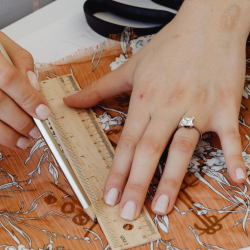A music producer is the creative force behind crafting songs that captivate listeners and stand the test of time. In recent years, the world has seen a surge in interest in music production, fueled by the accessibility of advanced technology and an ever-growing passion for creating unique sounds. Whether it’s pop hits, cinematic scores, or experimental beats, music production has become a dynamic and sought-after art form, with enthusiasts and professionals alike striving to bring their musical visions to life.
In this article, you’ll explore how to produce your own music and discover the best music production software to elevate your creations. Additionally, you’ll learn about music production courses designed to help you master essential skills and techniques. Whether you’re a budding music producer or someone curious about art, this guide will equip you with the knowledge and resources needed to turn your passion for music into a creative reality.
Contents
Master the Art of Music Production: A Step-by-Step Guide for Music Producers ……………………… 1
What is a Music Producer? ………………………………………………………………………………………….. 1
What Does a Music Producer Do? …………………………………………………………………………………. 2
Steps to Produce Music ………………………………………………………………………………………………. 3
1. Software and Equipment …………………………………………………………………………………..3
2. Producing Music in a DAW ………………………………………………………………………………..3
3. Composing and Songwriting ……………………………………………………………………………… 4
4. Sound Design ………………………………………………………………………………………………… 4
5. Samples, Plugins, and MIDI ……………………………………………………………………………….
6. Sound Recording…………………………………………………………………………………………….. 4
7. Mixing Music …………………………………………………………………………………………………. 4
8. Music Mastering …………………………………………………………………………………………….. 5
How to Start a Music Production Career? ……………………………………………………………………….. 5
Final Thoughts ………………………………………………………………………………………………………….. 5
What is a Music Producer?
A music producer is a professional expert responsible for managing and overseeing the recording and production of an album, song, or any music project. They are important in shaping the sound and direction of the music, usually partnering closely with musicians, artists, and sound engineers to bring creative ideas to life.
From imagining a track to fine-tuning its final mix, a music producer makes sure every element—rhythm, melody, lyrics, and sound quality—aligns efficiently. Their expertise spans various aspects of music creation, including recording, arranging, recording, mixing, and mastering, making them an important part of the music-making process.
What Does a Music Producer Do?
A music producer is a cornerstone of the process of creating songs and albums, acting like a catalyst for the entire music production process. They fill the gap between an artist’s vision and the final polished product, fusing creativity with technical expertise. From making the overall sound to managing recording sessions and assisting in the creative direction, music producers make sure that every aspect of a project comes together efficiently. Their role extends beyond just technical tasks—they also solve problems, mentor artists, and stay attuned to industry trends to make music that connects with audiences.
Here are the key roles and responsibilities of a music producer:
- Creative Direction
- Song Arrangement
- Collaboration
- Recording Supervision
- Technical Expertise
- Budget Management
- Problem-Solving
- Quality Control
- Trend Awareness
- Mentorship
- Creative Direction: Shapes the overall sound and style of a music project, ensuring it aligns with the artist’s vision.
- Song Arrangement: Decides on the structure, instrumentation, and arrangement of a track to enhance its appeal.
- Collaboration: Works closely with artists, musicians, and sound engineers to bring creative ideas to life.
- Recording Supervision: Oversees the recording sessions, ensuring high-quality audio capture and guiding performances.
- Technical Expertise: Utilizes music production software and equipment to mix, edit, and refine tracks.
- Budget Management: Manages the project’s financial resources, ensuring efficient use of time and money during production.
- Problem-Solving: Addresses challenges in the creative and technical aspects of production, finding solutions to improve the outcome.
- Quality Control: Ensures the final mix and master of a track meet professional industry standards.
- Trend Awareness: Keeps up with current music trends and technologies to stay relevant in the competitive industry.
- Mentorship: Offers guidance to artists, helping them grow and evolve in their craft.
- Steps to Produce Music
Producing music involves a creative and technical process that brings a musical idea to life. Below is a detailed breakdown of the steps and key components to guide you through creating professional-sounding tracks.
- Software and Equipment
- Producing Music in a DAW
- Composing and Songwriting
- Design Sound
- Samples, Plugins, and MIDI
- Sound Recording
- Mixing Music
- Music Mastering
1. Software and Equipment
The foundation of music production starts with the right tools:
- Digital Audio Workstation (DAW): A DAW is software that enables you to compose, record, edit, and mix music. Known options are FL Studio, Ableton Live, Pro Tools, and Logic Pro.
- Audio Interface: This hardware connects microphones and instruments to your system/computer, improving audio quality.
- Headphones and Studio Monitors: Top-quality headphones and speakers are important for accurate sound analysis.
- Microphones: Dynamic or condenser microphones are essential for recording live instruments and vocals.
- MIDI Controller: A MIDI keyboard/controller enables you to play and program melodies, chords, and beats.
2. Producing Music in a DAW
The main center for music creation is a DAW. To begin, follow these steps:
- Start a new session and define the track’s tempo and key.
- Incorporate instrument tracks, like synthesizers or virtual instruments, to lay the groundwork for your song.
- Arrange your track using the DAW’s timeline, structuring sections such as the intro, verse, chorus, and bridge
- Utilize automation to add dynamic variations in volume, effects, and tempo
3. Composing and Songwriting
In this process, lyrics, harmonies, and melodies are created:
- As the foundation of your song, begin with a simple melody or chord sequence.
- Compose lyrics that enhance your song’s narrative or vibe./li>
- To produce a seamless flow, try experimenting with various structures, such as verse-chorus-verse.
- To improve the composition, layer more components like harmonies or supporting
voices.
4. Sound Design
Sound design is the creative process of crafting unique audio elements to enhance your music’s originality:
- Use synthesizers to design custom sounds by tweaking parameters like oscillators, filters, and envelopes.
- Experiment with effects such as reverb, delay, distortion, and modulation to shape and refine the sound.
- Add energy and movement to your track with dynamic transitions like risers and impacts.
5. Samples, Plugins, and MIDI
These tools are crucial to bring depth and creativity to your music:
- Samples: Incorporate pre-recorded audio snippets like drums, vocal chops, or ambient textures. Many DAWs provide built-in libraries, or you can explore platforms like Splice for more options.
- Plugins: Expand your creative possibilities with virtual instruments and effects plugins, offering advanced sound manipulation features.
- MIDI Programming: Use MIDI to compose intricate melodies and rhythms, edit notes easily, and experiment with sounds without re-recording.
6. Sound Recording
Achieving high-quality recordings is vital for professional music production:
- Record vocals and live instruments using a microphone or direct input (DI).
- Capture multiple takes to ensure the best performance and combine them in the DAW.
- Monitor levels to avoid clipping or distortion during recording.
- Treat your recording space with acoustic panels to minimize noise and reflections.
7. Mixing Music
Mixing is the process of fusing all aspects cohesively:
- Adjust the volume levels of individual tracks to ensure balance and clarity.
- Enhance frequencies and remove unwanted noise using equalization (EQ).
- Use compression to manage dynamics and create consistency.
- Pan instruments and vocals across the stereo field to create a wider soundstage.
- Apply reverb and delay effects for added depth and atmosphere.
8. Music Mastering
The final stage of production polishes your track for distribution:
- Equalize the entire mix to achieve tonal balance.
- Use limiting to increase loudness without introducing distortion.
- Enhance width and depth with stereo imaging.
- Test your track on various playback systems (headphones, car speakers, etc.) for
compatibility. - Export the final version in high-quality formats like WAV or FLAC for streaming or CD
production.
By following these steps, you can turn your musical ideas into professional-quality tracks that captivate your audience.
How to Start a Music Production Career?
Starting a career in music production is both exciting and lucrative, but it requires the right skills, knowledge, and dedication. The journey begins with learning the fundamentals of music production, including sound design, mixing, mastering, and understanding industry-standard software like DAWs (Digital Audio Workstations). Building a strong portfolio, networking within the industry, and staying updated with the latest trends are also crucial steps for aspiring music producers.
If you’re ready to take the leap, enrolling in a structured program like AAFT Online’s Diploma in Music Production can be a game-changer. This comprehensive course covers everything from the basics of music theory to advanced production techniques, equipping you with the skills and confidence needed to produce professional-quality tracks. It also offers hands-on experience with the latest tools and software, making it the perfect launchpad for your career in music production.
Final Thoughts
Music production is an art that blends creativity with technical skills, transforming musical ideas into captivating tracks. Learning how to produce music involves mastering key steps like composing, sound design, recording, mixing, and mastering. These elements are crucial for creating professional-quality music that resonates with audiences.
For those looking to elevate their skills, enrolling in music production courses can provide the structured learning and hands-on experience needed to succeed. Programs like AAFT Online’s Diploma in Music Production cover everything from foundational techniques to advanced tools, offering the perfect platform to kickstart or advance your career in music production. With the right knowledge and dedication, you can turn your passion for music into a thriving profession.



















